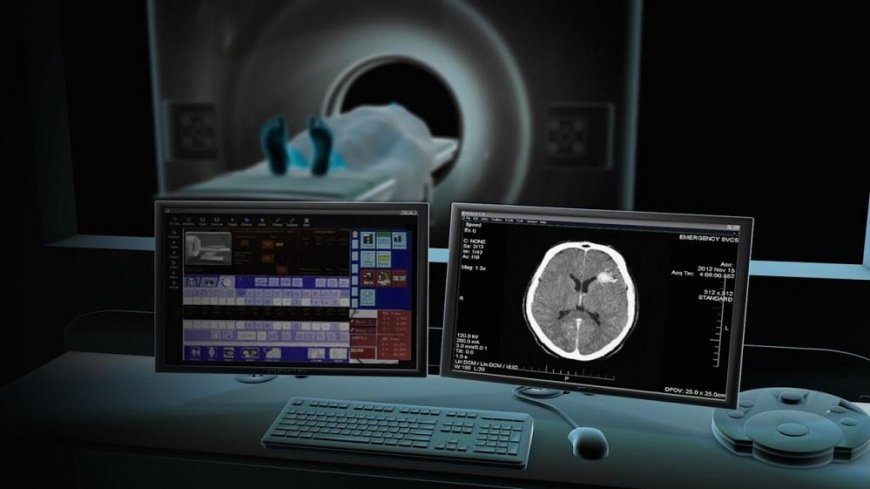Computed tomography: process, applications and threats
Computed tomography is a very useful test in the diagnosis of many diseases, because it allows for precise imaging of internal organs. Do you

Computed tomography is a very useful test in the diagnosis of many diseases, because it allows for precise imaging of internal organs. Do you want to know its process, uses and threats? Read on!
Imaging tests, such as arteriography and x-rays, are helpful in assessing the internal structures of the body. Another widely used form of examination is computed tomography, which analyzes the body from different angles using X-rays to create sections.
Computed tomography is a non-invasive scanning method that generates a two- or three-dimensional image of the internal structure of an object. This procedure is widely used in medicine to assess internal injuries. However, it turns out that other fields, such as industry and geology, are also making use of it.
In many studies, tomography is now one of the most frequently recommended research methods. This procedure has moved forward since its introduction in 1971, moving from displaying only images of the brain to being able to scan any anatomical region.
Computed tomography - what is assessed during the examination?
The imaging test is widely used in various fields of medicine, such as oncology, cardiology and traumatology. It can be used in the diagnosis and observation of patients with various clinical pictures. In addition, it is useful in planning radiotherapy.
Computed tomography shows the condition of both soft organs and bone tissue. In this sense, the liver, kidneys or brain and the surrounding bones can be assessed, thus enabling the accurate detection of many lesions.
It is the preferred test method for assessing different types of cancer as it confirms the presence and location of a tumor. It is also possible to study its features, allowing you to observe its size and its extension towards nearby tissue.
On the other hand, tomography is also used to study spinal injuries and assess bone density. It is also worth mentioning that it is very useful in examining the head, allowing the detection of cerebral hemorrhages.
Some people may need to use a contrast agent to better assess a specific area. In this case, it is recommended that you do not drink or eat in the hours leading up to the test. In addition, you must notify the doctor in case of allergies.
Pregnant women and people with heart, kidney or thyroid problems should inform a specialist. All these situations increase the likelihood of adverse effects during the test. Moreover, in the case of pregnant women, it is even a contraindication.
What does computed tomography look like?
The specialist will ask you to undress and put on a medical gown. If it is missing, wear loose-fitting clothing and make sure that there are no metal fasteners. If contrast is needed, it should be administered orally, intravenously or via enema.
Must Read: How to raise the level of happiness hormones
Computed tomography is a large machine with a bed and a central tunnel. Your doctor will advise you to lie on your back in bed, although in some cases it will be necessary to lie on your side or on your stomach. The bed may have straps and pillows to maintain the correct position of the patient's body.
At the beginning of the CT scan, the bed will move quickly to identify the area to be scanned. It will then slowly go through the scanner to make prints. In some cases, it is necessary to make multiple passes through the machine.
It is important to avoid movement when examining as it can generate printing errors called artifacts. Occasionally, you will be prompted to hold your breath for a few seconds.
After the exam is complete, you will have to wait a while for the doctor to confirm that the photos are of good quality. The results are ready in no time and the evaluation usually takes around 30 minutes.
Possible dangers and complications
Among the short-term risks associated with performing computed tomography, anxiety attacks stand out. This complication is very common in people with claustrophobia and in young children who are usually given a mild sedative beforehand.
On the other hand, this test also exposes patients to a type of radiation called ionizing radiation. Some studies link high doses of this type of energy to the development of cellular mutations. However, CT scans use very low levels of this radiation.
Despite the radiation emitted, computed tomography is a very common and safe examination, because the benefits of its performance far outweigh the risks. However, specialists should exhaust options that emit less radiation before pointing it out.
Children are usually sedated with mild medications prior to the test so they don't have an anxiety attack.
Computed tomography - interpreting the results
Within minutes of completing the examination, the radiologist will evaluate the relevant results. Images are usually stored in a digital file, so they should be viewed on a computer screen.
A radiologist is a specialist responsible for the supervision and interpretation of tests, thanks to which he is able to detect any abnormalities. After analyzing the results, the specialist will prepare a report that must be provided to the attending physician.
A procedure with more benefits than risks
Computed tomography is an imaging test that uses simultaneous X-rays to examine soft organs and bone tissue. However, it exposes people to up to 100 times more radiation than traditional X-rays, which can cause long-term risks.
The chances of being damaged are greater in children than in adults because their cells reproduce more quickly. Nevertheless, doctors still use this test to detect many diseases because its benefits far outweigh the risks presented.
